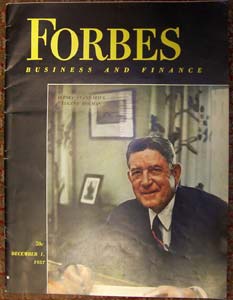
1954 – Bertie Forbes dies. His sons continue to run the magazine.
Forbes kept the magazine afloat during the Depression with income from his syndicated column, which remained in existence until 1943. He died in 1954. His son Malcolm became a well-known figure while running the magazine, and although its circulation rose in the 1950s and 1960s after languishing for most of the post-Depression time period, Forbes magazine had fallen behind its two greatest competitors. Malcolm, with the help of editor James Michaels, pushed the magazine to become more critical and to analyze the business world, not merely laud it. The strategy worked. By 1976, Forbes passed Fortune again in circulation.
Forbes represented an important point in the history of business journalism. Its founder was one of the first well-known business journalists in the country – not just to businesspeople but to readers. And its brand of business journalism – focusing on the people and investing – would set the stage for a widening of the business reporting genre.
Forbes today remains a smart magazine that is typically ahead of the curve on business issues. In 1984, for example, it was the first business publication to explain Michael Milken’s junk bond issues and how they were changing business. In its May 4, 1987 issue, it talked about spotting the top of the stock market. Five months later, the market plunged in its biggest one-day loss since 1929.